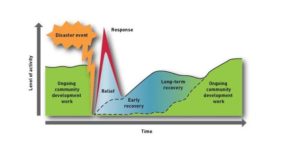Recovery is the process of dealing with the impacts of an emergency and returning social, economic, infrastructure and natural environments to an effective level of functioning.
What is successful recovery?
Successful recovery is community-led. Affected communities play a key role in guiding and delivering recovery assistance at the municipal level, with support and coordination at regional and state levels, depending on the complexity and magnitude of the event.
Recovery starts during the emergency response and encompasses linked and overlapping phases of relief and short term recovery, early recovery planning and medium to long term recovery.
Recovery aims to empower people and communities to participate in activities that restore community wellbeing and economic activity, and involves coordinated efforts across government, non-government, community and private sector organisations.
This chart and the text below depicts the Transition from Response to Recovery Process and on page 114 of the TEMA Issue 1 there is more detail. It is important to understand that as soon as practical after the operational response has ended that information relating to the emergency is to be transferred to the State Recovery Coordinator.
Steps in the process include:
- The emergency event
- Initial ongoing community development work
- Early recovery-Relief
- Long term recovery-Response
- Ongoing community development work.
In accordance with section 24F of the Emergency Management Act, all information relating to the emergency is to be transferred to the State Recovery Coordinator (if appointed) as soon as practicable after the operational response has ended. This constitutes a formal transition from response to recovery.

Recovery governance arrangements
Effective coordination, planning and communication is essential. Recovery efforts generally involve all levels of government, including municipal, regional and state emergency management structures, as well as non-government and community organisations. Recovery Governance arrangements is demonstrated in the flow chart.
During an emergency relief and short term recovery the following occurs:
- State Control Centre-SCC-in control
- Regional Emergency Coordination Centre-RECC-communicates/reports up to the SCC and down to Municipal Coordination Centre-MECC
- Regional Social Recovery Team liaises between RECC and MECC.
After an Emergency long-term recovery (event specific) the Recovery Task-force or Unit collaborate with the Affected Area Recovery Committees.

That brings us to the completion of this module
In summary
- Tasmania’s emergency management arrangements reflect our geography, demographics and values.
- As an island state, our transport networks are critical and energy supply security is vitally important
- The State’s natural and cultural heritage needs to be protected
- The Tasmanian Emergency Management Arrangements support Tasmanians to become more disaster resilient
- The Arrangements define activities that mitigate risks and outline whole-of-State, regional and municipal preparedness measures and describe how to effectively respond to, and recover from, the impacts of emergencies
- The Arrangements are dynamic and responsive to change.

Most documents are available on the SES webpage-supporting documents and resources: publicly as SES- Tasmania Emergency Management Arrangement
The majority of these documents can be accessed WebEOC. Watch the following video to gain an overview of this platform WebEOC File Library . Other links below:
- State Special Emergency Management Plans and Associate Plans-WebEOC-Municipal Councils website
- Tasmanian Disaster Resilience Strategy 2020-2025
- SEMC Strategic Directions Framework 2020-2025
- Tasmanian Emergency Evacuation Framework
- Managing Exercises: A handbook for Tasmanian Government Agencies
- People at Risk in an Emergency
- Municipal Emergency Management Guidelines
- Australian Institute for Disaster Resilience (AIDR) Knowledge Hub
- Australasian Fire and Emergency services Authority

